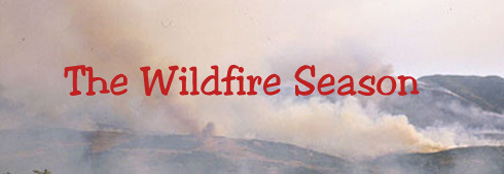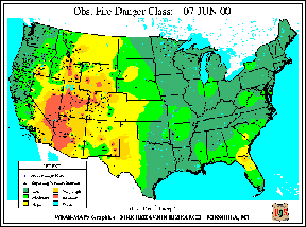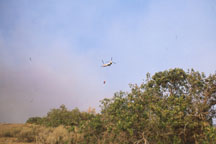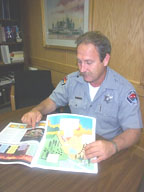|
Bulletin Board
June 12, 2000
There is growing concern about the potential this summer for wildfires in the West. Experts are warning that this year may be comparable to 1988, when the West
experienced numerous wildfires, including the Yellowstone National Park blaze. According to the Fire Danger Class Map most of the West including the entire state of
Utah, is either high, very high and areas with extreme danger. See Obs. Fire Danger Class: 07-June-00 map. To see current conditions go to (www.fs.fed.us/land/wfas/fd_class.gif). The Wasatch Front is currently rated at a very
high risk. The Los Alamos, New Mexico fire may be a harbinger a things to come in the entire western region. During the past week the southern part of Utah was under a
fire closure order with fires restricted to campsites and smoking to inside automobiles.
Along the Wasatch Front, less than normal precipitation and unseasonably warm June weather have given rise to a long, hot and dry summer. According to Russ Hone, Salt Lake City Watershed Administrator, this summer could
be a bad year for fires. Over his 28 years of service with Salt Lake City, he estimates that he has seen more than 40 wildfires within the City's 185 square miles of
Wasatch watershed east of Salt Lake City and the urban interface. Staffed with thirteen employees and 2 fire apparatus, Hone is part of a larger network of fire
fighting organizations starting with federal, state and local government agencies. "Our greatest threat for wildfires is in the low elevation watersheds of City Creek,
Emigration, Red Butte and Parleys Canyons, and the urban interface between the Wasatch Mountains and the homes located on the upper city benches," says Hone.
"This is the same area over which we have primary responsibility." These areas are grassy and covered with scrub oak that provides ample fuel for wildfires. According
to Hone, the scrub oak produces an oily substance that furthers its burning potential. Careless people and lightning strikes cause most of the fire. “Fireworks are the
forest’s worst enemy,” says Hone. Most years fireworks are banned near the urban interface and within the watershed areas.
|
In 1988 a helicopter drops water on the wildfire in Emigration Canyon.
|
Hone describes fighting a wildfire much like dealing with a living organism, in that the fire requires oxygen and fuel to burn. It can create its own wind, sometimes up to 100 miles per hour,
racing faster than a human can run to escape to safety. This is why wildfire fighters carry a “fire shelter.” The shelter provides a place to shield against being burned. The trapped fire fighter
gets inside the small tent shelter and tightly seals the entrance. “The wildfire will burn over the shelter leaving the individual unharmed – you may be able to survive,” says Hone.
Up until 1993, Salt Lake City and the U.S. Forest Service had an interlocal agreement to jointly fight wildfires within the Wasatch. However, this relationship no longer exists
and has been replaced with other agreements between the federal government and the state of Utah. "The cooperation between the Forest Service, the state, county and city
is excellent," says Hone, “Salt Lake City's 1999 Canyon Watershed Master Plan requires an in-depth review and rewrite of our fire fighting program." Prescribed fires
will be part of that review, including identifying those areas that must be attacked and suppressed versus allowed to burn naturally to remove the storehouse of fuels. Hone
says, "The new thinking is that wildfires are not bad for the environment and in some cases they are absolutely positive, enhancing wildlife and promoting improved habitat
growth." This hasn't been decided, but will be part of the studies required in the watershed management plan.
|
1988 Wildfire -- Wildland fire fighters move from Little Mountain towards Emigration Canyon.
|
Hone reflects on the 1988-fire season, noting that this was the worst year in his memory. Beginning on April 12, the Perry’s Hollow fire burned the urban interface above the City’s
north bench. Similar small fires were common that summer along the Wasatch Front. On September 2, a major fire started in Affleck Park in Dell Fork of Parleys Canyon by an illegal campfire. It quickly spread westward
into Emigration Canyon. The potential for property loss was great, triggering a response from a federal “Overhead Team.” Four air tankers and two helicopters were called
into service along with 80 wildfire fighters. Within 24 hours a small city was established to command the fire fighting effort, including a communications center,
showers and restrooms, staging area and media center. Before the fire could be suppressed 5,600 acres of mountain watershed was burnt in Dell Fork, Emigration
and Red Butte Canyons. Due to the critical nature of the watershed, within the week restoration work was underway to re-vegetate and control erosion in the burnt areas.
|
Russ Hone explains how to “Live With Fire” from information contained in this free publication.
|
In preparing for this and other wildfire seasons, the Department of Public Utilities has received a FEMA Project Impact grant to provide public information on wildfires. “Living With Fire – A guide for the home
owner,” is a publication prepared by a coalition of agencies that make up the Great Basin Fire Prevention group consisting of the BLM, USFS Intermountain Region, Idaho Department of Lands, Utah Forestry Fire and State Lands,
and Nevada Division of Forestry. It gives valuable information to homeowners to live more safely in this fire environment by taking pre-fire precautions to improve the survivability of people and property. Under the FEMA
grant, this information is available upon request. Furthermore, Mr. Hone will speak to community councils and other groups about this program. Or if individuals want a copy they can call
483-6705 for a copy of “Living With Fire.” Included in this publication is checklist of things to do in the event that a wildfire is approaching a home or structure that is occupied.
Mr. Hone requests that when in the foothills and in the Wasatch Canyons, please excercise great care to avoid setting a wildfire, and if these areas are closed to fireworks, please obey the order.
Questions regarding this article can be e-mailed to: russ.hone@ci.slc.ut.us
Other Website prevention/education and wildland urban interface
Fire Wise: www.firewise.org
Fire Safe Council: www.firesafecouncil.org
Fema: www.fema.gov
National Interagency Fire Center: www.nifc.gov
Smokey Bear: www.smokeybear.com
|




